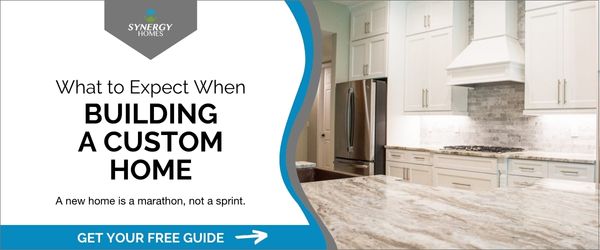When the time is right to build a new home, you have already invested months (or years) in dreaming of it, designing it in your mind, filling it with color, texture, and comfort, and imagining the lifelong memories you will make there. After all this, it seems like every second that comes between you and your house is much too long! Remember, this is a marathon, not a sprint – but the good news is that you’re nearing the finish line. What is the timeline for building a new home? What can you expect?
Timeline for Building a New Home
According to the US Census Bureau, the average time, across the industry, for a new build is about 8-9 months. Of that, the construction timeline for building a new home accounts for the bulk of the process, about 6.7 of those months.
It is important to remember that this will differ based on your location, the type of house you are building, and the construction process itself. And, of course, today, we cannot ignore supply chain issues that make accessing important materials and supplies more challenging. Now, we mentioned the “type of house.” A full custom house will typically take every bit of that 8-9 month timeline – or more, depending on the builder and their experience and expertise. A home built according to a predesigned floor plan will take less time, and you still have the option to customize it to a significant extent, if you wish. To know what to expect, let’s take a look at key steps in the process that will impact the timeline for building a new home:
-
Financing
Up to 90 Days
Most Americans require financing when building a home. For fully custom builds, you may need a loan for land, construction, and a mortgage. With semi-custom, you may find it beneficial to work with a lender trusted by your builder. Here, you may receive some price breaks, upgrades, or “extras,” like having your closing costs covered.
-
Signing Your Contract with the Builder
Three – Six Weeks
After you’ve done your homework (scoping out their website/social presence, reading reviews, checking BBB, talking to former clients, asking any and all questions, etc.), it’s time to sign on the dotted line. Review your contract carefully, with help from a real estate attorney if desired. Make sure you are crystal clear on every term and clause.
-
Permits
Three to Four Weeks
During this interval, your builder will work on all the permits and approvals needed to start your home. Here’s where experience comes in: they should be familiar with what legal steps are necessary in terms of zoning, construction, land use, etc. It’s not the most exciting part of the process, to be sure – but it is one that is critical.
-
Site Preparation
One to Two Months
Your site may be prepared. In which case, skip ahead! If not, though, you need to consider aspects like the location of utilities, driveway placement, power lines, removal of trees, shrubs, rocks, and rubble, leveling (if necessary), soil compaction, leveling, and more. If your site needs more extensive preparation, you could be looking at a month or two.
-
Construction Begins!
Three Weeks – If All Goes Well!
Now, here’s where it gets exciting! Your builder will break ground and start with footings, foundations, and framing. Soon, you’ll see the “skeleton” of your home taking shape. During this phase, there will also be home inspections and visits from municipal officials to give the go-ahead for your builder to continue. Weather can be an issue here. For example, if it’s wet and rainy, it will delay your schedule as concrete foundations cannot set and dry. There’s not much you can do about the weather.
-
Design
Two Weeks
As your home starts to come to life, you will want to review your selections in terms of fixtures, colors, and other materials. You will also want to finalize any customizations you want. This is a good time to make sure your water heater and HVAC systems are installed.
-
Interior and Exterior
Two to Three Weeks
When the bones are up, the next step is fleshing them out. Insulation, drywall, paint, flooring, closets, cabinets, molding, built-ins (e.g. shelves), and other elements are also on the schedule at this point for the interior. Outside, you’ll see brickwork/stucco/stone/siding installed, shingles nailed down, and gutters/eaves added. A lot is going on here, and you can see visual proof of your progress. From electrical and plumbing to inspections, you are getting closer to that finish line.
-
Finishing Details
Three Weeks
Everything is happening now: light fixtures, faucets, tubs/showers, toilets, sinks, appliances, countertops, carpeting/tile, doors… It is all coming together.
-
Inspection and Appraisal
One to Two Weeks
When the front door is installed (typically the last step) building officials come in for a final inspection. If all goes to plan, they issue a certificate of occupancy. You can also have your inspector visit to see if there are any items that the builder needs to fix (scratches, dents, dings, etc.). Your lender will then appraise the home to determine its market value and finalize your funding.
-
Walkthrough, Closing, and Getting Those Keys
One to Two Weeks
You’re so close. At this point, you’ll do a walkthrough with the builder. Ask any questions you have racing through your mind. Look at everything closely; you want to make sure you are 100% satisfied. When you close, you’ll sign document after document, finalize your funding, and… get your keys! You can settle in, unpack, decorate… and pop that bottle of bubbly to celebrate.
Come Home
The preparation and construction timeline for building a new home can be streamlined when you work with an experienced builder. Contact Synergy Homes to discuss your dream house, and then… Let’s build it.

Comments are closed here.